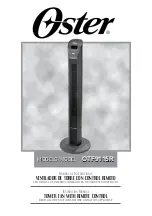
12’–24’ BASIC 6
®
WWW.BIGASSFANS.COM ©2012 DELTA T CORP. ALL RIGHTS RESERVED
36
Additional Input Power Considerations
This section points out additional requirements that may be needed for the fan system to operate properly. To encourage a trouble-free
fan system, additional input considerations should be addressed prior to installation.
Input voltage irregularities
CAUTION: One device is required for each fan controller.
The fan controllers are suitable for direct connection to input power within the rated voltage of the fan controller, but are sensitive to
rapid changes in supply voltage. Below are certain input power conditions that may cause nuisance tripping, such as Overvoltage
and Undervoltage faults. If any of the conditions exist as described below, you can install one of the devices listed under the heading
“Corrective Action” on the input side of the fan controller.
Input power condition
Corrective action
Low line impedance (less than 1% reactance)
Install line reactor. Consult your Big Ass Fans representative
for recommended part number.
Line has power factor correction capacitor
Line has frequent power interruptions (voltage sags or swells)
Line has intermittent noise spikes in excess of 6000V (lightning)
Phase-to-ground voltage exceeds 125% of normal line to line voltage Install Delta/Wye isolation transformer with grounded
secondary (1:1 turns ratio).
Ungrounded distribution system
Supply transformer exceeds established kVA limit
Install line reactor.
More than one controller per branch circuit
Delta secondary
CAUTION: Care must be taken when connecting to a three-phase 240/120 V secondary as shown below. All fan controller
models rely on internal references made between each incoming phase and ground. To prevent nuisance tripping such as
Overvoltage and Undervoltage faults, 200–250 V, three phase fan controllers should be connected so that the High leg, or
“phase B,” terminates on “L2” of the fan controller’s input power terminals.
CAUTION: Avoid installations utilizing supply transformers with a 480V delta secondary (ungrounded, corner grounded,
open). Proper fan operation cannot be guaranteed due to a lack of proper phase-to-ground voltage references.
There are many different arrangements available for industrial and commercial power distribution in North America. The most common
are the following:
• 575 V/330 V, Three-Phase (Wye Secondary)
. Provides 575 V between phases, and 330 V from each phase to Neutral/Ground.
• 480 V/277 V, Three-Phase (Wye Secondary)
. Provides 480 V between phases, and 277 V from each phase to Neutral/Ground.
• 208 V/120 V, Three-Phase (Wye Secondary)
. Provides 208 V between phases, and 120 V from each phase to Neutral/Ground.
• 240 V/120 V, Three-Phase (Delta Secondary)
. Provides 240 V between phases for three-phase loads, 120 V from phase “A” and
“C” to Neutral/Ground, and 208V from phase “B” to Neutral/Ground as shown below. In this transformer arrangement, phase “B” is
commonly referred to as a “Wild Leg” or “High Leg,” and shall be marked accordingly with an orange finish or other effective means
per NEC 110.15.
“B” Phase
“C” Phase
Neutral / Ground
“A” Phase
120 V
120 V
240 V
240 V
240 V
208 V
Controllers damaged by any of the conditions mentioned below may not be covered by Big Ass Fans warranty policy.
Summary of Contents for Basic 6
Page 1: ...INSTALLATION GUIDE For help call 1 877 BIG FANS or visit www bigassfans com Basic 6 ...
Page 6: ...Notes ...
Page 48: ...Notes ...
Page 50: ......
Page 63: ......
















































